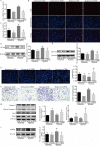TRB3 mediates vascular remodeling by activating the MAPK signaling pathway in hypoxic pulmonary hypertension
- PMID: 34906150
- PMCID: PMC8670293
- DOI: 10.1186/s12931-021-01908-4
TRB3 mediates vascular remodeling by activating the MAPK signaling pathway in hypoxic pulmonary hypertension
Abstract
Background: Hypoxic pulmonary hypertension (PH) is a refractory pulmonary vascular remodeling disease, and the efficiency of current PH treatment strategies is unsatisfactory. Tribbles homolog 3 (TRB3), a member of the pseudokinase family, is upregulated in diverse types of cellular stresses and functions as either a pro-proliferative or pro-apoptotic factor depending on the specific microenvironment. The regulatory mechanisms of TRB3 in hypoxic PH are poorly understood.
Methods: We performed studies using TRB3-specific silencing and overexpressing lentiviral vectors to investigate the potential roles of TRB3 on hypoxic pulmonary artery smooth muscle cells (PASMCs). Adeno-associated virus type 1(AVV1) vectors encoding short-hairpin RNAs against rat TRB3 were used to assess the role of TRB3 on hypoxic PH. TRB3 protein expression in PH patients was explored in clinical samples by western blot analysis.
Results: The results of whole-rat genome oligo microarrays showed that the expression of TRB3 and endoplasmic reticulum stress (ERS)-related genes was upregulated in hypoxic PASMCs. TRB3 protein expression was significantly upregulated by hypoxia and thapsigargin. In addition, 4-PBA and 4μ8C, both inhibitors of ERS, decreased the expression of TRB3. TRB3 knockdown promoted apoptosis and damaged the proliferative and migratory abilities of hypoxic PASMCs as well as inhibited activation of the MAPK signaling pathway. TRB3 overexpression stimulated the proliferation and migration of PASMCs but decreased the apoptosis of PASMCs, which was partly reversed by specific inhibitors of ERK, JNK and p38 MAPK. The Co-IP results revealed that TRB3 directly interacts with ERK, JNK, and p38 MAPK. Knockdown of TRB3 in rat lung tissue reduced the right ventricular systolic pressure and decreased pulmonary medial wall thickness in hypoxic PH model rats. Further, the expression of TRB3 in lung tissues was higher in patients with PH compared with those who have normal pulmonary artery pressure.
Conclusions: TRB3 was upregulated in hypoxic PASMCs and was affected by ERS. TRB3 plays a key role in the pathogenesis of hypoxia-induced PH by binding and activating the ERK, JNK, and p38 MAPK pathways. Thus, TRB3 might be a promising target for the treatment of hypoxic PH.
Keywords: Hypoxia; MAPK; PASMCs; PH; TRB3.
© 2021. The Author(s).
Conflict of interest statement
The authors declare that they have no competing interests.
Figures








References
-
- Tajsic T, Morrell NW. Smooth muscle cell hypertrophy, proliferation, migration and apoptosis in pulmonary hypertension. Compr Physiol. 2011;1:295–317. - PubMed
MeSH terms
Substances
Grants and funding
LinkOut - more resources
Full Text Sources
Medical
Molecular Biology Databases
Research Materials
Miscellaneous

